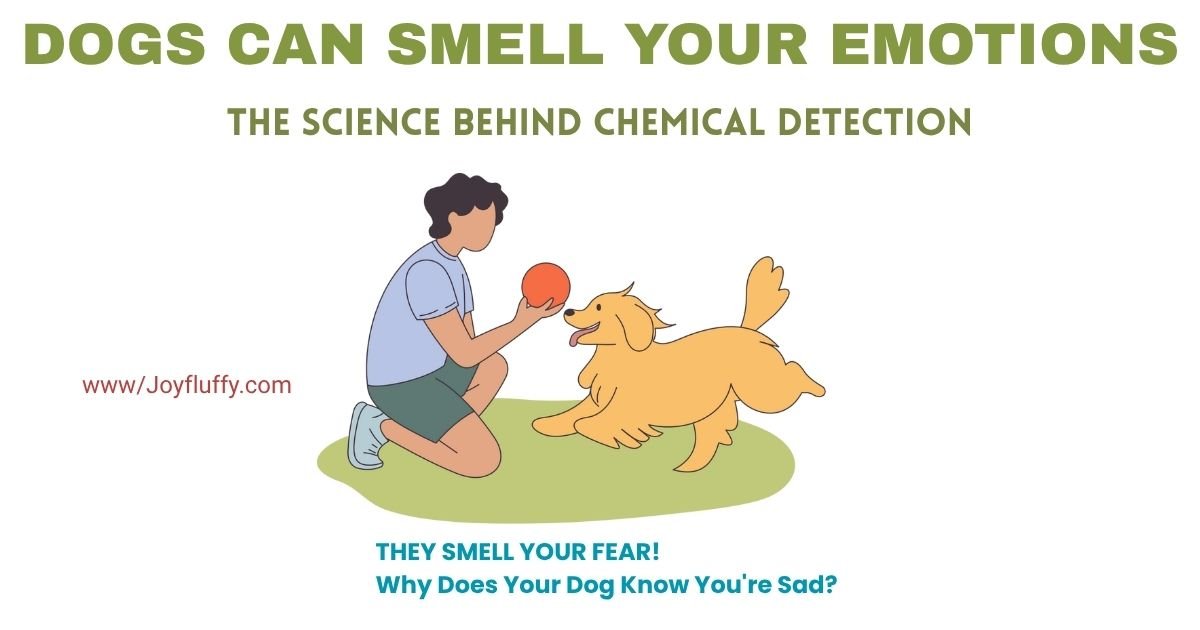Dogs Can Smell Your Emotions Through Chemical Changes
Have you ever noticed your dog acting differently when you are upset, anxious, or excited? There is a scientific reason for this behavior that goes far beyond simple observation. Dogs can actually smell your emotions through chemical changes in your body. This remarkable ability allows our canine companions to detect fear, happiness, stress, and other emotional states with astonishing accuracy, often before we even realize what we are feeling ourselves.
The connection between humans and dogs stretches back thousands of years. During this time, dogs have evolved sophisticated ways to understand us, and one of their most impressive abilities is detecting our emotional states through scent. This is not a matter of dogs reading body language alone, though they are excellent at that too. Scientific research has proven that dogs can literally smell the chemical compounds our bodies release when we experience different emotions.
Understanding how dogs smell emotions gives us deeper insight into the incredible bond we share with our pets. It also explains why dogs are so effective as therapy animals, emotional support companions, and medical alert dogs. Just as birds evolved remarkable abilities from their dinosaur ancestors, dogs have developed their own extraordinary sensory capabilities through evolution and domestication.
The Science Behind Canine Smell
Before we dive into how dogs detect emotions, we need to understand just how powerful their sense of smell really is. The canine nose is one of nature’s most sophisticated sensory organs, far surpassing human olfactory capabilities in almost every measurable way.
Dogs have approximately 300 million scent receptors in their noses, compared to only 6 million in humans. This gives them a sense of smell that is 10,000 to 100,000 times more sensitive than ours.
The physical structure of a dog’s nose contributes to this incredible ability. When a dog sniffs, air flows through their nostrils and is divided into two paths. One path goes directly to the lungs for breathing, while the other goes to a specialized olfactory chamber where scent molecules are analyzed. This chamber is lined with millions of scent receptors that can detect incredibly small concentrations of chemical compounds.
Additionally, the portion of a dog’s brain devoted to analyzing smells is proportionally 40 times larger than the corresponding area in human brains. This means dogs not only detect more scents but also process scent information with greater sophistication than we can imagine. According to research from the American Kennel Club, dogs can detect some odors in parts per trillion, which is roughly equivalent to detecting a teaspoon of sugar in two Olympic-sized swimming pools.
What Are Chemosignals?
The key to understanding how dogs smell emotions lies in something called chemosignals. These are chemical compounds that our bodies release through various means, including sweat glands, breath, and skin secretions. Different emotional states trigger the release of different chemosignals, creating a unique chemical signature for each emotion.
When you experience an emotion, your brain triggers the release of specific hormones and neurotransmitters. These chemicals circulate through your bloodstream and eventually find their way to your skin’s surface through sweat glands. They also affect your breath composition. Dogs can detect these molecular changes in real-time, giving them immediate awareness of your emotional state.
Humans actually release chemosignals all the time, but we have largely lost the ability to consciously detect them in each other. Dogs, however, have retained and refined this ability. Research published in scientific journals has demonstrated that dogs can distinguish between sweat samples collected from humans experiencing different emotional states, even when no other cues are present.
How Dogs Detect Different Emotions
Each emotion triggers distinct chemical changes in the human body, and dogs have learned to recognize these patterns. Let us explore how dogs detect some of the most common emotional states.
Fear and Anxiety
Adrenaline
Cortisol
Norepinephrine
When humans experience fear or anxiety, our bodies activate the fight-or-flight response. This triggers the release of stress hormones including adrenaline and cortisol. These hormones increase our heart rate, raise our blood pressure, and cause us to sweat more. The sweat produced during fearful or anxious states has a distinctly different chemical composition than sweat produced during exercise or in hot weather.
Dogs can smell this fear-based sweat with remarkable accuracy. Studies have shown that dogs behave differently when exposed to the scent of fearful humans compared to calm humans. They often become more alert, cautious, or protective when they detect fear, suggesting they understand this smell indicates potential danger.
Happiness and Joy
Serotonin
Dopamine
Oxytocin
Positive emotions trigger the release of feel-good chemicals like serotonin, dopamine, and oxytocin. These hormones affect our body chemistry in ways that dogs can detect. When we are happy, our breathing patterns change, becoming more relaxed and deeper. We also produce different compounds in our sweat compared to when we are stressed.
Research shows that dogs respond positively to the scent of happy humans. They are more likely to approach, show affection, and engage in play when they detect these positive emotional chemosignals. This creates a feedback loop where happy humans make dogs happy, which in turn makes humans happier.
Stress and Distress
Cortisol
Epinephrine
Chronic stress produces consistently elevated levels of cortisol in our bodies. This stress hormone affects numerous bodily functions and creates a persistent change in our chemical signature that dogs can detect. Unlike acute fear, which triggers immediate high-level responses, stress produces a more sustained chemical pattern.
Many therapy dogs and emotional support animals are specifically trained to respond to stress signals. They learn to offer comfort, pressure therapy, or attention-seeking behaviors when they detect elevated stress chemosignals in their handlers. However, even untrained family dogs often naturally respond to human stress with comforting behaviors.
Sadness and Depression
Decreased Serotonin
Altered Cortisol
When humans experience sadness or depression, our body chemistry changes in complex ways. Levels of certain neurotransmitters like serotonin may decrease, while stress hormones may be affected. Our breathing patterns also change, and we may produce different compounds in our tears and sweat.
Dog owners frequently report that their pets seem to know when they are sad and offer comfort accordingly. Scientific research supports these observations, showing that dogs can indeed detect the chemical changes associated with sadness and often respond with behaviors designed to provide comfort, such as staying close, offering physical contact, or attempting to engage in play to lift their owner’s mood.
Scientific Studies on Dogs Smelling Emotions
The ability of dogs to smell human emotions is not just anecdotal evidence or wishful thinking. Rigorous scientific research has confirmed this capability through controlled experiments.
Key Research Findings
A groundbreaking study published in 2018 by researchers at Queen’s University Belfast demonstrated that dogs could detect stress with remarkable accuracy. The study collected breath and sweat samples from participants before and after they completed a stressful mental arithmetic task. Dogs were then presented with these samples and asked to identify which came from the stressed state.
The results were striking: dogs correctly identified the stress samples with 93.8% accuracy. This research proved conclusively that dogs can distinguish between stressed and non-stressed human states based solely on smell, with no other cues available.
Another important study conducted by researchers in Italy examined how dogs respond to human emotional odors. They collected sweat samples from humans watching videos designed to elicit either fear or happiness. When dogs were exposed to these samples, they showed distinctly different behavioral and physiological responses. Dogs exposed to fear-scented samples showed increased heart rate and stress behaviors, while those exposed to happiness-scented samples showed more relaxed, social behaviors.
Research from studies on chemosignals has further confirmed that dogs can detect a wide range of human emotional states through smell alone. These studies have implications not just for understanding dog behavior but also for training service dogs, therapy animals, and medical alert dogs.
Accuracy rate of dogs detecting human stress through smell alone, according to scientific research conducted at Queen’s University Belfast.
Why Did Dogs Evolve This Ability?
The ability to detect human emotions through smell did not happen by accident. It is the result of thousands of years of evolution and domestication that created the unique relationship between humans and dogs.
Dogs were domesticated from wolves between 20,000 and 40,000 years ago. During this time, dogs that were better at understanding and responding to human needs were more successful. They received more food, better shelter, and more opportunities to reproduce. This created evolutionary pressure favoring dogs with enhanced abilities to read human emotional states.
Being able to smell human emotions provided several survival advantages for early dogs. A dog that could detect when a human was fearful could prepare for potential danger. A dog that could sense happiness might know it was a good time to approach for food or affection. A dog that could identify stress or illness in a human could adjust its behavior accordingly, perhaps becoming more protective or gentle.
The relationship between humans and dogs represents one of the most successful examples of interspecies cooperation in nature. As dogs evolved to better understand humans, humans evolved to work more effectively with dogs. This mutual evolution strengthened the bond and made both species more successful. The ability to detect emotions through smell is just one of many adaptations that dogs developed during this process.
Practical Implications of This Ability
Understanding that dogs can smell your emotions has important practical applications in how we interact with our canine companions and use them in various working roles.
Service and Therapy Dogs
The ability to detect emotions through smell makes dogs exceptionally effective as service and therapy animals. Medical alert dogs can be trained to detect specific chemical changes associated with conditions like diabetes, seizures, or PTSD episodes. These dogs provide warnings that allow their handlers to take preventive action before a medical crisis occurs.
Therapy dogs working in hospitals, schools, and other settings naturally respond to the emotional states of the people they interact with. Their ability to smell stress, anxiety, or sadness allows them to provide targeted comfort to those who need it most. This is not just the dog being friendly to everyone equally, but rather a sophisticated response to detected emotional needs.
Training and Behavior
Knowing that dogs can smell your emotions affects how we should approach training and behavior modification. When you are stressed or frustrated during training sessions, your dog can smell these emotions. This may make them more anxious or less receptive to learning, as they pick up on your negative emotional state.
Training Tip
Before starting a training session with your dog, take a few moments to calm yourself and get into a positive emotional state. Your dog will smell your confidence and calmness, making them more receptive to learning. If you are feeling frustrated or stressed, it is better to postpone training until you can approach it with a better mindset.
Understanding Your Dog’s Reactions
If your dog suddenly becomes clingy, anxious, or behaves unusually, consider whether you might be experiencing emotional changes that your dog is detecting. Many people report that their dogs seemed to know they were sick before they realized it themselves, or that their dogs became more protective during stressful life periods. These behaviors make sense when we understand that dogs are constantly monitoring our emotional and physical state through smell.
What This Means for Dog Owners
The fact that dogs can smell your emotions changes how we should think about our relationship with our pets. Your dog is not just passively living in your home. They are actively monitoring your emotional state and responding to it, even when you think you are hiding your feelings.
“Your dog knows how you feel before you fully understand it yourself. They are reading your body’s chemical language in ways that even other humans cannot. This makes them uniquely qualified to be our companions, offering support and connection that goes beyond words or visible expressions.”
This understanding should make us more mindful of our emotional state around our dogs. If we are consistently stressed or anxious, our dogs will detect this and may become stressed themselves. Creating a calm, positive environment benefits not just us but our canine companions as well.
It also explains why the human-dog bond is so strong. Dogs are not just responding to what we show on the surface. They are responding to our authentic emotional state, detected through chemical signals we cannot consciously control. This creates a level of genuine connection that is rare between species.
Can You Hide Your Emotions From Your Dog?
The short answer is no. While you might be able to hide your emotions from other humans through facial expressions and body language, you cannot hide the chemical changes in your body from your dog’s sensitive nose. Your dog knows when you are afraid even if you put on a brave face. They know when you are sad even if you smile and act cheerful.
This might seem uncomfortable at first, but it actually represents an opportunity for greater authenticity in our relationship with our dogs. You do not need to pretend around your dog because they already know how you really feel. This can be incredibly comforting, as it means your dog’s affection and support is based on knowing the real you, not just the version you present to the world.
Other Animals That Can Detect Human Emotions
While dogs are exceptional at detecting human emotions through smell, they are not the only animals with this ability. Horses, cats, and even some birds show sensitivity to human emotional states. However, dogs appear to be particularly skilled at this task, likely due to their long history of close cooperation with humans.
The study of how animals perceive and respond to human emotions is an active area of research. As we learn more about these abilities, we gain deeper appreciation for the complex ways that different species can connect and communicate across the boundaries that separate us.
The Future of Research
Scientists continue to study how dogs detect and respond to human emotions. Future research may help us better understand the specific chemical compounds dogs are detecting, how they process this information, and how we can use this knowledge to improve the training and effectiveness of working dogs.
There is also growing interest in whether dogs can be trained to detect specific medical conditions through smell even more reliably than current methods. Dogs are already being used experimentally to detect certain types of cancer, Parkinson’s disease, and other conditions. As we better understand the mechanisms behind their olfactory abilities, we may develop new medical applications.
Emerging Research Areas
- Identifying specific volatile organic compounds associated with different emotional states
- Understanding breed differences in emotion detection abilities
- Developing training protocols to enhance dogs’ natural emotion-detection skills
- Exploring whether dogs can distinguish between genuine and faked emotions
- Investigating how dogs’ emotion detection changes throughout their lifespan
- Studying the role of emotion detection in reducing human stress and anxiety
How to Support Your Dog’s Emotional Awareness
Since we now know that dogs are constantly monitoring our emotional state through smell, we can take steps to support this natural ability and use it to strengthen our bond with our pets.
Create Emotional Consistency
Dogs thrive on consistency and predictability. When your emotional state is erratic or constantly stressed, it can create anxiety in your dog. Work on managing your own emotional health through stress reduction techniques, regular exercise, and healthy lifestyle choices. Your dog will benefit from the more stable emotional environment.
Acknowledge Your Dog’s Responses
When your dog responds to your emotional state by offering comfort or staying close, acknowledge this behavior. This reinforces the bond between you and validates your dog’s role as an emotional support companion. Even if your dog cannot fix what is making you sad or stressed, their awareness and presence can be genuinely comforting.
Be Aware During Vet Visits
Your anxiety about vet visits can transfer to your dog through the fear chemosignals you release. If you are anxious, your dog will smell this and may become more fearful themselves. Before vet appointments, practice calm breathing and try to approach the situation with a relaxed mindset. Your dog will pick up on your calmer emotional state.
Use Positive Associations
When you are in a genuinely happy, relaxed state, spend quality time with your dog. Play together, train together, or simply enjoy each other’s company. Your dog will associate these positive emotional chemosignals with good experiences, strengthening your bond and creating positive memories.
Common Misconceptions About Dogs and Emotions
While dogs can indeed smell human emotions, there are some common misconceptions about this ability that need to be addressed.
Misconception 1: Dogs Can Read Your Mind
Dogs detect chemical changes in your body, not your thoughts. They know you are anxious, but they do not know why you are anxious or what you are thinking about. Their remarkable ability is based on chemistry, not telepathy. They respond to your emotional state without understanding the complex reasons behind it.
Misconception 2: All Dogs Are Equally Sensitive
While all dogs have superior smell compared to humans, individual dogs vary in how attuned they are to human emotions. Some dogs are naturally more sensitive and responsive, while others may be less focused on human emotional states. Breed, individual personality, training, and the strength of the human-dog bond all influence how well a particular dog responds to human emotions.
Misconception 3: Dogs Always Want to Help
Just because a dog can smell your emotions does not mean they always want to or know how to respond helpfully. Some dogs may become anxious themselves when they detect strong negative emotions. Others might not have learned appropriate comforting behaviors. The ability to detect emotions and the motivation or training to respond appropriately are two different things.
Misconception 4: Emotional Detection Replaces Medical Care
While dogs can detect some medical conditions through chemical changes, they are not a replacement for professional medical care. If your dog is acting unusually around you, it might indicate they are detecting something wrong, but you should still consult with healthcare professionals rather than relying solely on your dog’s behavior as a diagnostic tool.
The Role of Oxytocin in the Human-Dog Bond
When we interact positively with our dogs, both humans and dogs experience increases in oxytocin, often called the “love hormone.” This chemical is the same one that bonds parents with their children. The release of oxytocin creates feelings of attachment, trust, and affection.
Interestingly, this creates a positive feedback loop. When you look at your dog with affection, your body releases oxytocin. Your dog can smell this chemical change and responds positively, which causes their own oxytocin levels to rise. This chemical exchange strengthens the bond between you and creates the deep connection that dog owners cherish.
Research has shown that when humans and dogs gaze into each other’s eyes, both species experience a surge in oxytocin levels. This is the same bonding mechanism that exists between human mothers and their infants. Dogs are the only non-human species known to create this oxytocin response through eye contact with humans, highlighting the unique nature of the human-dog relationship.
Implications for Animal Welfare
Understanding that dogs can smell our emotions has important implications for animal welfare and how we treat dogs in various settings.
In shelter environments, stressed and anxious workers and volunteers may inadvertently create more stress for the dogs in their care. The dogs can smell the stress, which may make them more anxious and less adoptable. Shelters that prioritize staff wellbeing and create calm environments may see better outcomes for their animals.
In training facilities, veterinary clinics, and grooming salons, the emotional state of handlers and workers directly affects the dogs they work with. Professionals who remain calm and positive, even in challenging situations, will have more success because the dogs they work with can smell their emotional stability.
This knowledge also emphasizes the importance of not using fear or intimidation in dog training. When a trainer uses harsh methods that create fear, the dog smells not just their own fear response but potentially the trainer’s aggression or negative emotional state. This creates an environment that inhibits learning and damages the human-dog bond.
Cultural Perspectives on Dogs and Emotions
Different cultures have varying relationships with dogs, but across virtually all cultures where dogs are kept as companions, people report that their dogs seem to understand their emotions. This universal observation, now confirmed by science, suggests that the ability of dogs to detect human emotions through smell is a fundamental aspect of the human-dog relationship rather than a cultural phenomenon.
In many indigenous cultures, dogs have long been recognized as spiritual or emotional guides. While these beliefs were often dismissed as superstition by Western science, modern research now provides a scientific basis for understanding how dogs might indeed serve as emotional companions with abilities that exceed simple behavioral observation.
Comparing Dogs to Other Pets
While cats, rabbits, and other common pets can certainly form bonds with their owners, dogs appear to be uniquely specialized in detecting and responding to human emotions. This is likely due to the much longer period of close cooperation and co-evolution between humans and dogs.
Cats, for example, have excellent senses of smell, but they were domesticated much more recently than dogs and have maintained more independence. They may be able to detect some human emotional states through smell, but they appear less focused on this ability and less motivated to respond to it compared to dogs.
This does not mean dogs are “better” pets, but rather that they have evolved a specialized niche in their relationship with humans that centers on emotional attunement and cooperation. Different pets offer different types of companionship, and the emotional sensitivity of dogs is one of their defining characteristics.
The portion of a dog’s brain devoted to analyzing smells is proportionally 40 times larger than the corresponding area in human brains, allowing for sophisticated scent processing.
What Dog Owners Should Know
If you are a dog owner, understanding that your dog can smell your emotions should inform how you interact with your pet and what you expect from them.
First, recognize that your emotional state affects your dog more than you might realize. Your stress becomes their stress. Your calm becomes their calm. This does not mean you need to be perfectly serene at all times, but it does mean being aware that your dog is affected by your emotional state.
Second, appreciate that your dog’s responses to your emotions are not random or coincidental. When your dog offers comfort during difficult times, they are responding to real chemical signals they have detected. Their support, while not solving your problems, represents genuine awareness and response to your emotional needs.
Third, use this knowledge to deepen your relationship with your dog. Understanding that your dog perceives your authentic emotional state can encourage greater emotional honesty and acceptance in your relationship. You do not need to pretend to be happy around your dog when you are sad. They already know, and their acceptance of your true emotional state can be profoundly comforting.
The Science Continues to Evolve
Research into how dogs smell emotions is still relatively new, and scientists continue to make discoveries that deepen our understanding of this remarkable ability. Each new study reveals more details about the specific mechanisms involved, the range of emotions dogs can detect, and the practical applications of this knowledge.
As research methods improve and our understanding of both canine and human biology advances, we will likely discover even more about the chemical communication that occurs between humans and dogs. This ongoing research not only satisfies our curiosity but also has practical implications for training working dogs, improving mental health support, and strengthening the human-animal bond.
The ability of dogs to smell your emotions through chemical changes represents one of the most fascinating aspects of the human-dog relationship. This is not merely a cute anecdote or wishful thinking, but a scientifically proven capability that dogs have evolved over thousands of years of living alongside humans. Your dog’s nose is constantly analyzing the chemical signature of your emotional state, providing them with information about how you feel that goes far beyond what you consciously communicate. This remarkable ability explains why dogs make such effective therapy animals, loyal companions, and beloved family members. They do not just live with us; they are deeply attuned to our emotional lives in ways that even other humans cannot match. Understanding this ability should deepen our appreciation for our canine companions and remind us of the profound connection that exists between our two species.
Taking Action Based on This Knowledge
Now that you understand how dogs smell your emotions through chemical changes, you can use this knowledge to improve your relationship with your dog and enhance both your lives.
Consider working on your own emotional regulation and stress management. This is not just good for you; it creates a calmer environment for your dog. Practice mindfulness, engage in regular exercise, maintain healthy sleep habits, and seek support when you need it. Your dog will benefit from the more balanced emotional state you achieve.
Pay attention to how your dog responds to your different emotional states. You may notice patterns where your dog becomes more clingy when you are stressed, more playful when you are happy, or more gentle when you are sad. Understanding these patterns helps you interpret your dog’s behavior and can even serve as an early warning system for your own emotional state.
If you are considering getting a dog, this information highlights the responsibility involved. Dogs are not just passive pets; they are emotionally aware companions who will be affected by your emotional state. This makes them wonderful sources of support and connection, but it also means you should be prepared to provide emotional stability and care in return.
For those training dogs or working with dogs professionally, understanding emotional detection through smell should inform your methods. Creating calm, positive training environments and managing your own emotional state becomes essential for success. The dogs you work with are constantly reading your emotional signature, and they will respond better when they detect calm confidence rather than frustration or anxiety.






One Comment